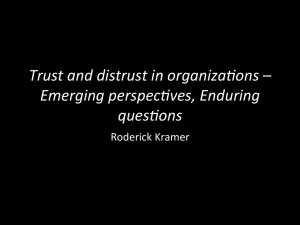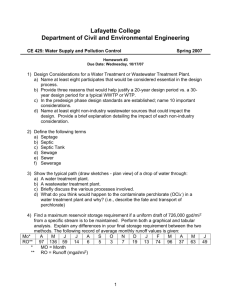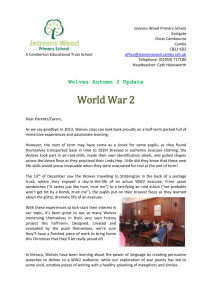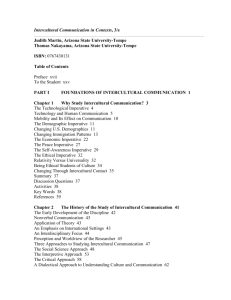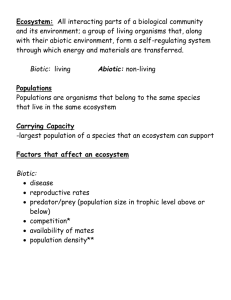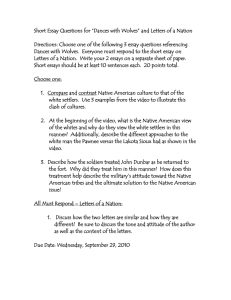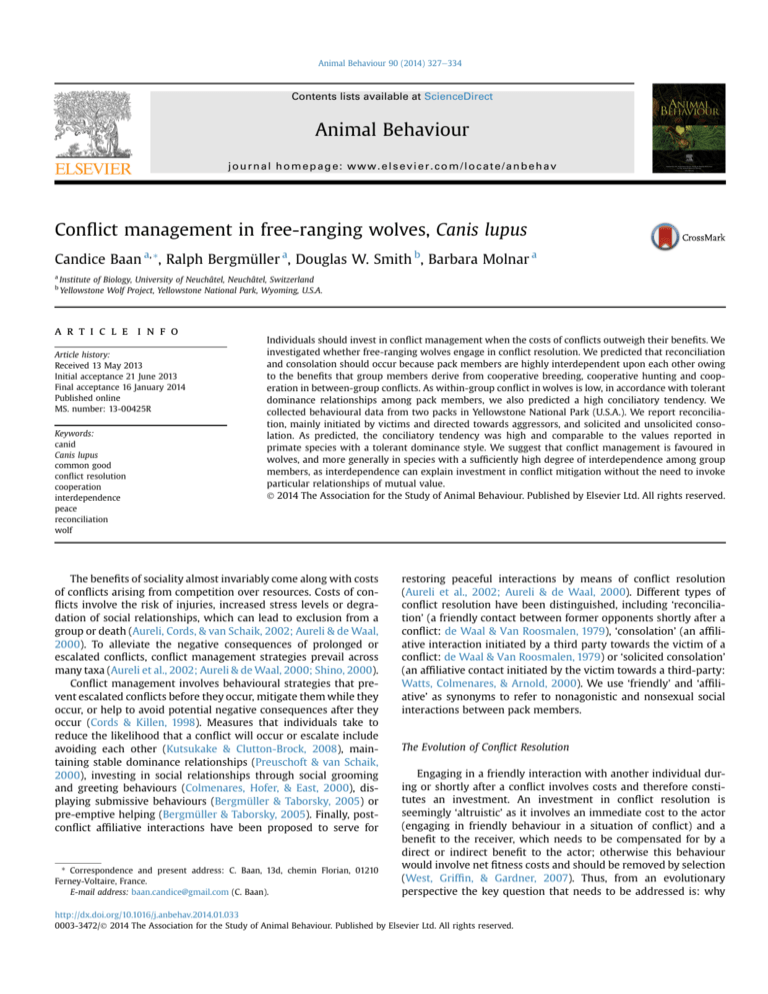
Animal Behaviour 90 (2014) 327e334
Contents lists available at ScienceDirect
Animal Behaviour
journal homepage: www.elsevier.com/locate/anbehav
Conflict management in free-ranging wolves, Canis lupus
Candice Baan a, *, Ralph Bergmüller a, Douglas W. Smith b, Barbara Molnar a
a
b
Institute of Biology, University of Neuchâtel, Neuchâtel, Switzerland
Yellowstone Wolf Project, Yellowstone National Park, Wyoming, U.S.A.
a r t i c l e i n f o
Article history:
Received 13 May 2013
Initial acceptance 21 June 2013
Final acceptance 16 January 2014
Published online
MS. number: 13-00425R
Keywords:
canid
Canis lupus
common good
conflict resolution
cooperation
interdependence
peace
reconciliation
wolf
Individuals should invest in conflict management when the costs of conflicts outweigh their benefits. We
investigated whether free-ranging wolves engage in conflict resolution. We predicted that reconciliation
and consolation should occur because pack members are highly interdependent upon each other owing
to the benefits that group members derive from cooperative breeding, cooperative hunting and cooperation in between-group conflicts. As within-group conflict in wolves is low, in accordance with tolerant
dominance relationships among pack members, we also predicted a high conciliatory tendency. We
collected behavioural data from two packs in Yellowstone National Park (U.S.A.). We report reconciliation, mainly initiated by victims and directed towards aggressors, and solicited and unsolicited consolation. As predicted, the conciliatory tendency was high and comparable to the values reported in
primate species with a tolerant dominance style. We suggest that conflict management is favoured in
wolves, and more generally in species with a sufficiently high degree of interdependence among group
members, as interdependence can explain investment in conflict mitigation without the need to invoke
particular relationships of mutual value.
Ó 2014 The Association for the Study of Animal Behaviour. Published by Elsevier Ltd. All rights reserved.
The benefits of sociality almost invariably come along with costs
of conflicts arising from competition over resources. Costs of conflicts involve the risk of injuries, increased stress levels or degradation of social relationships, which can lead to exclusion from a
group or death (Aureli, Cords, & van Schaik, 2002; Aureli & de Waal,
2000). To alleviate the negative consequences of prolonged or
escalated conflicts, conflict management strategies prevail across
many taxa (Aureli et al., 2002; Aureli & de Waal, 2000; Shino, 2000).
Conflict management involves behavioural strategies that prevent escalated conflicts before they occur, mitigate them while they
occur, or help to avoid potential negative consequences after they
occur (Cords & Killen, 1998). Measures that individuals take to
reduce the likelihood that a conflict will occur or escalate include
avoiding each other (Kutsukake & Clutton-Brock, 2008), maintaining stable dominance relationships (Preuschoft & van Schaik,
2000), investing in social relationships through social grooming
and greeting behaviours (Colmenares, Hofer, & East, 2000), displaying submissive behaviours (Bergmüller & Taborsky, 2005) or
pre-emptive helping (Bergmüller & Taborsky, 2005). Finally, postconflict affiliative interactions have been proposed to serve for
* Correspondence and present address: C. Baan, 13d, chemin Florian, 01210
Ferney-Voltaire, France.
E-mail address: baan.candice@gmail.com (C. Baan).
restoring peaceful interactions by means of conflict resolution
(Aureli et al., 2002; Aureli & de Waal, 2000). Different types of
conflict resolution have been distinguished, including ‘reconciliation’ (a friendly contact between former opponents shortly after a
conflict: de Waal & Van Roosmalen, 1979), ‘consolation’ (an affiliative interaction initiated by a third party towards the victim of a
conflict: de Waal & Van Roosmalen, 1979) or ‘solicited consolation’
(an affiliative contact initiated by the victim towards a third-party:
Watts, Colmenares, & Arnold, 2000). We use ‘friendly’ and ‘affiliative’ as synonyms to refer to nonagonistic and nonsexual social
interactions between pack members.
The Evolution of Conflict Resolution
Engaging in a friendly interaction with another individual during or shortly after a conflict involves costs and therefore constitutes an investment. An investment in conflict resolution is
seemingly ‘altruistic’ as it involves an immediate cost to the actor
(engaging in friendly behaviour in a situation of conflict) and a
benefit to the receiver, which needs to be compensated for by a
direct or indirect benefit to the actor; otherwise this behaviour
would involve net fitness costs and should be removed by selection
(West, Griffin, & Gardner, 2007). Thus, from an evolutionary
perspective the key question that needs to be addressed is: why
http://dx.doi.org/10.1016/j.anbehav.2014.01.033
0003-3472/Ó 2014 The Association for the Study of Animal Behaviour. Published by Elsevier Ltd. All rights reserved.
328
C. Baan et al. / Animal Behaviour 90 (2014) 327e334
should an individual invest in conflict resolution? Investments in
conflict resolution have been proposed (1) to restore relationships
that are particularly important to individuals such as coalitions,
alliances, partnerships or friendships (the ‘valuable relationship
hypothesis’: de Waal & Aureli, 1997), (2) as ‘honest’ signals to social
partners indicating that a conflict is over (Silk, 2000), or (3) to
support the wellbeing of a valuable social partner such as kin, or
other individuals with strong mutual attachments such as friends
(consolation: Watts et al., 2000).
Here we propose that cooperation theory integrates these potential explanations. According to the concept of interdependence
(Roberts, 2005) one individual should promote or invest in another,
when the fitness of the donor depends on the fitness of the receiver.
Valuable relationships can be considered as a special case of
interdependence in which both partners profit from the valuable
relationship. As the concept of interdependence is a more general
explanation for cooperative investments, it can also explain
asymmetrical investments in conflict resolution. While selection
should favour reconciliation when the investment is of self-serving
interest to the donor (e.g. to protect a relationship that is valuable
to the donor), selection should favour consolation when the donor
has an interest in the fitness of the receiver. Interdependence can
also explain investments in common goods such as social peace
within a group (Roberts, 2005).
interactions have recently been reported in captive wolves (Cordoni
& Palagi, 2008; Palagi & Cordoni, 2009) and domestic dogs (Cools,
Van Hout, & Nelissen, 2008), they have not yet been investigated
in free-ranging wolves (Packard, 2012).
Ecological Factors Favouring Conflict Resolution
Study Site and Individuals
In primates, species with tolerant dominance relationships
show a high conciliatory tendency while species with more
despotic dominance relationships tend to engage more rarely in
reconciliation (Thierry, 2000). The socioecological model of Sterck,
Watts, and van Schaik (1997) predicts despotic dominance relationships in primates when within-group competition is high and
when between-group competition is low. In contrast, tolerant
dominance relationships prevail under the opposite conditions:
when within-group competition is low and between-group conflict
is high (Sterck et al., 1997). This leads to the prediction that low
levels of within-group conflict and associated tolerant dominance
relationships should favour investments in conflict resolution.
Under these conditions, individuals can engage in friendly behaviour in a situation of conflict with low risk of incurring renewed
aggression. In line with several studies suggesting that betweengroup conflict can foster within-group cooperation (Radford,
2011; Sterck et al., 1997; West et al., 2006), high levels of
between-group conflict have been proposed to foster within-group
investments in conflict resolution (Shino, 2000).
The fieldwork took place in Yellowstone National Park, U.S.A.
(44 600 N; 110 550 W) from 1 November 2008 to 31 March 2009, in
agreement with the national park policy (permits YELL-2008-SCI
5716 and YELL-2009-SCI 5716). We studied two free-ranging
packs of grey wolves, the Druid Peak pack and the Blacktail Deer
Plateau pack, whose home ranges were located on the northern
range of the park (Smith et al., 2008, 2009). The Druid Peak pack
was established in 1996 (Smith & Ferguson, 2005) and consisted of
16 wolves (12 females, four males). It was structured as a nuclear
family (Packard, 2003) with all members born into the pack except
for the breeding male. By the end of 2008, the pack consisted of six
pups, two yearlings and eight adults. The Blacktail Deer Plateau
pack was founded in November 2008 and consisted of dispersing
males from the Druid Peak pack and dispersing females from the
Agate Creek pack. In November 2008, the pack consisted of 10 individuals (7 yearlings (5 males) and 3 adults (1 male)). One of these
individuals (a yearling female) probably died, and two others
(yearling males) dispersed during the winter (Smith et al., 2008,
2009; C. Baan & B. Molnar, personal observation).
Should Conflict Resolution Be Predicted in Wolves?
Fieldwork
Members of a wolf pack are interdependent as individuals rely
on the benefits they derive from cooperative hunting, cooperative
breeding (also referred to as ‘alloparental care’; Packard, 2003) and
cooperation in between-group contests (MacNulty, Smith, Mech,
Vucetich, & Packer, 2012; Mech & Boitani, 2003; Packard, 2003).
In free-ranging wolves, agonistic interactions between pack
members rarely escalate (Mech & Boitani, 2003). In contrast, the
territoriality of the species leads to elevated between-group conflict with potentially highly injurious encounters (Mech & Boitani,
2003; Packard, 2003). In accordance with the predictions of the
primate socioecological model (Sterck et al., 1997), wolf sociality is
characterized by relaxed dominance relationships. Pack members
use elaborate displays that prevent conflict escalation and physical
harm in agonistic interactions. Subordinates also spontaneously
use submissive displays towards dominants, thereby acknowledging dominance relationships. While postconflict affiliative
Animals are captured and radiocollared every year for the purpose of local research, under the approval and authority of the
Institutional Animal Care and Use Committee of the United States
National Park Services. Our study was not involved in these processes and we did not use any advice allowing location of animals.
To locate the packs, we collaborated with the local crew, who used
telemetry, and also relied on tracks, howls and bird activity around
carcasses. The studied individuals were accustomed to the daily
presence of distant observers and our filming did not appear to
affect their behaviour.
We filmed the studied packs daily, from dawn to dusk, given
suitable weather conditions and sufficiently short distances to the
animals, which ranged from approximately 100 to 1500 m. We used
an adapted camcorder (Canon XL-H1 camcorder, Canon EF adapter
XL, Canon EF 100e400 mm f/4.5e5.6L IS USM photo lens, Canon
extender EF 2 II) to record social interactions among group
Predictions
We predicted investments in conflict resolution, including
reconciliation and consolation, in wolves because of the interdependence among pack members and because levels of conflict
within groups are low but those between groups are high. Given
the tolerant dominance style in wolves, we predicted a high
conciliatory tendency. As subordinates should be more interested
in terminating conflict, and as the risk of renewed aggression is low,
we expected victims of aggression to be more likely to invest in
reconciliation than aggressors. As elevated levels of conflict should
require higher investments in conflict mitigation, we predicted a
positive relationship between the number of aggressive behaviours
and the number of postconflict friendly behaviours among former
opponents. As is typical in species showing frequent postconflict
interactions (Aureli et al., 2002), we also expected specific friendly
behaviours in postconflict situations.
METHODS
C. Baan et al. / Animal Behaviour 90 (2014) 327e334
329
Table 1
Behaviours recorded from two wolf packs filmed in Yellowstone National Park in the winter 2008e2009
Type of behaviour
Aggressive behaviours
Growl
Approach dominant
Approach fast
Chase
Snap
T-position dominant
Push
Ride up
Stand over
Nip
Knockdown
Bite
Wrestle
Affiliative behaviours
Inspect*
Body contact
Play
Lick
Sniff
Greet
Greeting ceremony
Nose touch
Submissive behaviours
Passive submissive
Light submissive
T-position submissive
Other behaviours
Immobile
Travel
Howl
Nonsocial behaviours
Out of sight
Other
Description
Growl at conspecific with bared teeth; vocalization may be heard
Move towards another individual, with stiff forelegs and raised tail; piloerection possible
Move quickly towards an individual, by trotting or running; may include jumping on the conspecific or blocking its movement
Run after a conspecific, with piloerection, ears flattened
Shut jaws in the air
Stand as dominant in the T-formation, as the horizontal cross of the T, facing the chest of a conspecific
Push hard against a conspecific with part of body to make him/her move
Mount or jump on a conspecific with forelegs, in an aggressive posture (raised tail, may growl, piloerection), without pushing him down
Stand over, with piloerection and a stiff tail, a conspecific that is lying down
Brief inhibited bite, barely touching the conspecific, with insufficient pressure to cause injury
Hit or push down a conspecific
Bite a conspecific, without inhibition, with enough pressure to cause potential injury
Fight with a conspecific; violent encounter
Lick and/or sniff urogenital area of a conspecific
Body parts (excluding tails) of two individuals in contact for several seconds
Exaggerated, brief and/or inhibited motor patterns such as jump on, bite, chase, play bow
Lick part of a conspecific’s body, excluding urogenital area
Sniff part of a conspecific’s body, excluding urogenital area
Tail wagging, face oriented towards the face of a conspecific, sometimes licking
and/or sniffing and/or prolonged nose touch, ears oriented forward
Rally (>4 wolves), howling, greeting, tail wagging
Brief nose touch by one wolf to the face or body of another wolf; no tail wag, ears may be flattened
Lay on back or side, present stomach, throat and urogenital area, with tail tucked between legs
Tail tucked between legs, sometimes wagging, with body crouched, ears back; may lick or paw the dominant’s muzzle
Stand as subordinate in the T-formation, as the vertical cross of the T, facing the shoulder of the dominant
Lay down, sit or stand, look around or sleep
Walk, trot or run
Howl (head back, muzzle upward, vocalizing)
Out of sight
Behaviours other than those described above
This ethogram is based on personal observations and on published ethograms of domestic dogs (Cools et al., 2008) and captive wolves (Cordoni & Palagi, 2008).
* Although we considered ‘inspect’ to be a sexual interaction, not a friendly interaction, we included it in our data set for comparison with previous studies on wolves
(Cordoni & Palagi, 2008; Palagi & Cordoni, 2009) and domestic dogs (Cools et al., 2008).
members. To optimize recording of all possible social interactions,
two observers guided the cameraman using spotting scopes. We
interrupted recordings when individuals went out of sight for more
than 1 min, or when wolves were resting.
Video Analyses
Videotapes were loaded on a computer and analysed using the
Noldus software, the Observer 5.0. We coded every single agonistic
interaction between individuals using the all-occurrences sampling
method (Altmann, 1974). We identified individuals based on
distinctive external features (presence/absence of a collar, fur
colour patterns, age-related characteristics, unique physical characteristics). For each aggressive encounter, we recorded all social
behaviours during a postconflict (PC) period of 10 min directly
following an aggressive interaction (Palagi & Cordoni, 2009). We
focused on the victim, defined as the recipient of the aggression.
When the focal individual went out of sight for more than 30 s, the
PC period was considered over. For each PC period, we selected a
corresponding matched control (MC) period of 10 min to obtain
data about baseline behaviour (i.e. without a preceding conflict). An
MC period was considered over if the focal individual went out of
sight for more than 30 s. We selected the MC periods according to
the following criteria: the focal individual was not involved in any
conflict during the 10 min preceding the onset of an MC period (de
Waal & Yoshihara, 1983); the opponents of the corresponding PC
period were within 10 m of each other and thus had the
opportunity to interact (Palagi, Antonacci, & Norscia, 2008); inactive (e.g. sleeping, resting) episodes were not used as MC periods.
Matched control observations are challenging to acquire in freeranging populations, and the use of periods immediately preceding a conflict as matched controls may not be representative of
baseline conditions (Aureli et al., 2002). To deal with these constraints, each MC period was selected on the first possible day
following the corresponding PC period, with a maximum interval of
1 week between PC and MC periods.
For each interaction in PC and MC periods, we identified the
initiator and the recipient of the interaction. We recorded all behaviours listed in Table 1, the starting time and the duration of each
interaction. Submissive behaviours were not considered as affiliative behaviours.
Statistics
We used SPSS statistical software (version 18.0.0, SPSS, Inc.,
Chicago, IL, U.S.A.; version 20.0.0, IBM Corp., Armonk, NY, U.S.A.) in
data analyses. As the data did not follow a normal distribution, we
mostly used nonparametric tests (for one exception see below).
We used a chi-square test to investigate whether there was a
difference in the occurrence of affiliative behaviours between PC
and MC periods. To avoid pseudoreplication, we used only the first
interaction within each pair combination in the analysis.
To discriminate between two consecutive aggressive interactions among the same partners within a given PC period, we
C. Baan et al. / Animal Behaviour 90 (2014) 327e334
RESULTS
Do Free-ranging Wolves Engage in Postconflict Affiliation?
From a total of 106 h of video recordings (Blacktail Deer Plateau
pack: 49 h; Druid Peak pack: 57 h), we collected 68 observation
periods (i.e. 34 PC and 34 MC periods; for details see the Appendix).
Considering all conflicts (34 initial, 7 renewed) in PC periods,
reconciliation, consolation and solicited consolation occurred
following 61.0% (N ¼ 25), 4.9% (N ¼ 2) and 19.5% (N ¼ 8) of the
conflicts, respectively. After 14.6% of conflicts (N ¼ 6), the victim
350
300
250
200
150
100
50
PC
MC
Period
Figure 1. Mean latency SE until the first affiliative contact in postconflict (PC) and
matched control (MC) periods for both wolf packs.
was not involved in any affiliative interaction. Renewed aggression
occurred in 20.5% of PC periods (N ¼ 7) but never twice in the same
PC period. Redirection of aggression by the victim towards a third
party occurred only twice; we did not consider these events as new
aggressive encounters.
The first affiliative contact occurred significantly earlier after a
conflict (PC) than in the matched control period (MC) (t test, not
assuming equal variances: t24.9 ¼ 2.5, NPC ¼ 30, NMC ¼ 24,
P ¼ 0.02; Fig. 1).
The number of first affiliative behaviours performed by or towards the focal individual (victim) during the first minute was
significantly higher after a conflict (PC) compared to the control
situation (MC) (chi-square test: c21 ¼ 6:095, N ¼ 42, P ¼ 0.014).
After the first minute, there was no significant difference between
the two periods (Fig. 2).
Also, the total number of affiliative behaviours performed by or
towards the victim was significantly higher in the PC periods than
in the corresponding MC periods during each of the first 4 min
(minute 1: c12 ¼ 29.032, N ¼ 124, P < 0.0001; minute 2: c12 ¼ 12.938,
N ¼ 65, P < 0.0001; minute 3: χc12 ¼ 14.297, N ¼ 37, P < 0.0001;
minute 4: c12 ¼ 4.167, N ¼ 24, P ¼ 0.041). After that, there was no
significant difference between the two periods. We calculated a
conciliatory tendency of 44.1%.
Number of first affiliative behaviours
used a bout criterion interval method (Martin & Bateson, 1993). We
calculated the minimal period between two distinct conflicts by
performing a log survivorship plot. This allowed us to consider an
agonistic interaction as renewed aggression when it occurred at
least 2 min after the previous agonistic interaction (Palagi &
Cordoni, 2009).
If conflict resolution prevails, affiliative interactions should
occur earlier in PC periods than in corresponding MC periods. We
recorded the latency until the first affiliative behaviour involving
the focal individual in both PC and corresponding MC periods. We
performed a t test that does not assume equal variances between
groups. We pooled data from both studied packs and treated each
interacting pair as one independent data point. For this analysis, we
excluded all cases in which no affiliative behaviour occurred during
PC and MC periods.
According to the time-ruled method (Aureli, van Schaik, & van
Hooff, 1989), we compared the number of first affiliative contacts
occurring each minute in PC and in MC periods. We also grouped
the data for each minute in PC and in MC periods.
Conciliatory tendency gives a quantitative indication of the
occurrence of reconciliation and is used to compare groups or
species (Veenema, Das, & Aureli, 1994). Values close to 50% correspond to a high conciliatory tendency whereas values close to 0%
are considered as low (Thierry, 2000). We calculated the corrected
conciliatory tendency (CCT) in each wolf pack, including all pairs of
opponents. Based on the recorded latency (in min) until the first
affiliative interaction between former opponents in each pair of PC
and MC periods, we labelled the pair ‘attracted’ if the first friendly
contact occurred earlier or only in the PC period, ‘dispersed’ if the
affiliative contact occurred earlier or only in the MC period, and
‘neutral’ if the affiliative interaction took place after the same
amount of time in both periods or when no such interaction
occurred (Veenema et al., 1994). We calculated the CCT as the
number of attracted minus dispersed pairs, divided by the total
number of pairs.
To assess whether investment in reconciliation is correlated with
the intensity of a conflict (estimated as the number of aggressive
behaviours displayed in an interaction), we tested whether the total
number of aggressive and affiliative behaviours within each PC
period were correlated (Spearman rank correlation).
To determine whether a specific affiliative behaviour was preferentially used in reconciliatory interactions, we recorded the
occurrence of each type of affiliative behaviour first performed by
or towards the focal individual in PC and MC periods. We compared
the frequency of these specific behaviours, considering PC periods
and MC periods separately.
To investigate the pattern of conflict resolution in the studied
packs, we examined which individual (one of the former opponents
or a third party) initiated the first affiliative behaviour in PC periods. We analysed interactions between the former opponents
separately from interactions involving the victim and a third party.
We used chi-square analyses to test the observed values against
predicted values of a random distribution (50:50 ratio).
Latency until first affiliative contact (s)
330
35
30
25
20
PC
MC
15
10
5
0
1
2
3
4
5
6
7
8
9
Time (min)
Figure 2. Temporal distribution of the first affiliative contact involving the victim in
postconflict (PC) and matched control (MC) periods for both wolf packs.
C. Baan et al. / Animal Behaviour 90 (2014) 327e334
There was a positive correlation between the number of affiliative and aggressive behaviours displayed during PC periods
(Spearman rank correlation: rS ¼ 0.379, N ¼ 34, P ¼ 0.027).
Which Specific Affiliative Behaviours Are First Displayed After a
Conflict?
Overall, there was a significant difference in the occurrence of
different types of affiliative behaviours (body contact, greeting,
inspecting, licking, nose touch, playing, sniffing) displayed in PC
and MC periods (c25 ¼ 27:91, N ¼ 46, P < 0.001). In particular,
licking (c21 ¼ 9:308, N ¼ 13, P ¼ 0.002) and nose touch
(c21 ¼ 8:333, N ¼ 12, P ¼ 0.004) occurred more often in PC periods,
while playing (no statistics, as N ¼ 4) and greeting (c21 ¼ 5:333,
N ¼ 8, P ¼ 0.021) occurred exclusively in MC periods.
Who Initiates Postconflict Affiliation?
Victims were more likely than aggressors to initiate postconflict
friendly contact with their former opponent (c21 ¼ 13:542, N ¼ 51,
P < 0.0001). We found no statistical difference in the propensity of
the victim or the third party to initiate postconflict affiliative contact (c21 ¼ 1:978, N ¼ 20, P ¼ 0.16; Fig. 3).
Does Postconflict Affiliation Reduce the Likelihood of Renewed
Aggression?
When comparing the likelihood of renewed aggressions in PC
interactions with friendly postconflict behaviour (no renewed
aggression: N ¼ 24; renewed aggression: N ¼ 6) and without
friendly postconflict behaviour (no renewed aggression: N ¼ 3;
renewed aggression: N ¼ 1), we found no significant difference
(c21 ¼ 0:05, P ¼ 0.81).
DISCUSSION
We observed reconciliation, consolation and a high conciliatory
tendency in free-ranging wolves. Initiation of reconciliation was
Number of first affiliative interactions
25
*
Initiator
Aggressor
Victim
Third party
20
15
10
5
0
With former opponent
With third party
Initiator of first postconflict interaction
Figure 3. Initiators of the first postconflict (PC) affiliative behaviour in PC periods for
both wolf packs. Data are given for interactions between former opponents (aggressor
and victim) and between the victim and a third party. *P < 0.0001.
331
asymmetric (mostly initiated by subordinates towards dominants),
which we suggest can be explained by the higher interest of subordinates to terminate the conflict. Overall, our results are in line
with the predictions that postconflict affiliative behaviours are
promoted by high, but asymmetric, interdependence among pack
members and low within-group conflict but high between-group
conflict.
Postconflict Affiliation in Wolves
Our results show that postconflict friendly behaviours were
mainly initiated by victims (subordinates) and preferentially
directed towards the former aggressors (dominants). Hence, subordinates appear to invest in conflict resolution to reduce social
tension (de Waal & Yoshihara, 1983) and to prevent further attacks
from dominants by signalling that they respect the prevailing
dominance relationships. Interdependence (Roberts, 2005), which
can also explain asymmetric investments in cooperation (pseudoreciprocity; Connor, 1986), provides an explanation: as subordinates rely on group membership, they invest in their
relationship with dominants to benefit from re-established
peaceful relationships and to prevent further attacks. In contrast,
dominants do not need to invest in their relationships with subordinates because they are not at risk of attack from them.
Former findings in captive wolves (Palagi & Cordoni, 2009) and
domestic dogs (Cools et al., 2008) reported consolation (initiated by
a third party) and solicited consolation (initiated by the victim).
Consolation has been linked to empathy (Romero, Castellanos, & de
Waal, 2010), for which there is evidence in dogs (Custance & Mayer,
2012) and which thus seems likely to prevail also in wolves. In our
study of free-ranging wolves, solicited consolation occurred
frequently while unsolicited consolation was more rare (probably
owing to our small sample size). The occurrence of consolation
suggests that investments in social peace or in relationships with
particular individuals due to interdependence (Roberts, 2005)
within a group are potentially relevant in wolves. In addition,
solicited consolation appears to result from the direct benefits, such
as reduced stress levels, that victims obtain by seeking comfort
from third parties (Fraser, Stahl, & Aureli, 2008).
Does Postconflict Affiliation Serve for Conflict Resolution in Wolves?
If postconflict affiliation serves for conflict resolution, renewed
aggression between former opponents should be less likely after
situations in which postconflict affiliation has occurred compared
to situations without postconflict affiliation. Although postconflict
affiliation did not reduce the likelihood of renewed aggression in
our study (we observed only a few cases of renewed aggression),
several lines of evidence suggest that postconflict affiliation in
wolves is best explained as conflict resolution.
First, affiliative and aggressive behaviours are typically antagonistic to each other. The finding that friendly behaviours occurred
mostly within the first minute after a conflict is typical for conflict
resolution and hard to explain alternatively.
Second, as predicted, we found a positive relationship between
the level of conflict escalation (i.e. the number of aggressive behaviours) and the number of affiliative behaviours displayed in PC
periods. Again, as affiliative behaviours are typically antagonistic to
aggressive behaviours, the results suggest that situations with a
higher degree of conflict escalation require increased investments
in conflict mitigation.
Third, two particular behaviours (licking and nose touch) were
the most frequent postconflict friendly behaviours that we
observed. Nose touch appears to be specific for conflict resolution
in free-ranging wolves. We suggest that individuals use nose touch
332
C. Baan et al. / Animal Behaviour 90 (2014) 327e334
as ‘excuse’ (asking the receiver’s forgiveness), which has been
suggested to be a prerequisite for reconciliation (Park & Enright,
2000). Specific affiliative behaviours, which seem to have an
excuse function, have, for instance, also been described in macaques (Aureli, Veenema, van Eck, & van Hooff, 1993; Thierry, 2000)
and cleaner fish (Bshary & Würth, 2001). The use of specific behaviours that are restricted to postconflict situations are characteristic of species with frequent postconflict interactions (Aureli
et al., 2002).
Finally, the finding that mostly victims of aggression engaged in
friendly behaviours towards the aggressors can most parsimoniously be explained by a conflict resolution function of these
behaviours.
Interdependence as an Explanation for Conflict Resolution in Wolves
Friendly postconflict interactions have been found to be
particularly likely among mutually valued partners that regularly
exchange affiliative behaviours, including pair partners, partners in
alliances, or friends (Aureli et al., 2002; de Waal & Aureli, 1997).
Such valuable partners should invest in avoiding or mitigating
escalated conflicts, which may damage relationships, thereby
jeopardizing future benefits of cooperation (Aureli et al., 2002;
Kutsukake & Clutton-Brock, 2008). Support for reconciliation
among valuable partners comes from primates (Arnold, Fraser, &
Aureli, 2010) and birds (Fraser & Bugnyar, 2011).
However, valuable relationships do not explain all observations
of conflict resolution as some studies did not find the predicted
reconciliation, such as for instance a comparison of human children
across cultures (Butovskaya, Verbeek, Ljungberg, & Lunardini,
2000) and investigations on cooperatively breeding callitrichids
(Schaffner & Caine, 2000). Asymmetrical investments in conflict
resolution by only one partner (as observed in this and other
studies: Aureli et al., 1989; Butovskaya et al., 2000; de Waal &
Yoshihara, 1983) suggest that the relationship does not necessarily need to be of similar value for both partners. The valuable
relationships hypothesis, which has been proposed to explain
protection and repair of relationships of mutual value to both
partners, is therefore one of several explanations for the occurrence
of friendly postconflict behaviour among former opponents (see
also Silk, 2000). Here, we suggest that conflict resolution in wolves
can be explained by investments of individuals that profit from
stable dominance relationships and group membership with no
need to invoke particularly valuable relationships.
Cords and Aureli (2000) proposed that three qualities of a
relationship might be important to influence conciliatory tendency,
that is, the value (what an individual gains from the partner), security (the perceived probability that the relationship will change)
and compatibility (the general climate of the relationship resulting,
for instance, from the personality of the partners). We suggest that
conflict resolution in wolves is partly explained by the security that
a dominant gains when a subordinate signals with a friendly
behaviour after a conflict that it will respect the existing dominance
relationships. This interpretation fits the alternative explanation
that friendly postconflict behaviours serve as costly (therefore
‘honest’) signals that indicate that the conflict is over (Silk, 2000). In
wolves, subordinates appear to use costly signals to terminate the
conflict and re-establish a peaceful relationship.
Hence, even though particular valuable relationships (which we
could not investigate in this study) may also be important to
explain reconciliation in wolves, our results suggest that conflict
resolution in this species can be explained by interdependence
among pack members as a result of the benefits they derive from
cooperative hunting, cooperative breeding and cooperation in
defence of the territory and related resources (MacNulty et al.,
2012; Mech & Boitani, 2003; Packard, 2003). The relevance of
interdependence could be tested in future studies. For instance, it
has been shown that the benefits of cooperative hunting in wolves
increase only up to a certain group size, but then declines thereafter, because some individuals fail to participate in cooperative
hunting (free riders), but profit from the effort of others (MacNulty
et al., 2012). Therefore, we predict that in larger packs (with lower
interdependence among pack members), investments in conflict
resolution should be lower compared to that in smaller groups (in
which interdependence among group members is higher).
A Comparative Perspective to Conflict Resolution in Wolves
Dominance style has been suggested to be important in
explaining the likelihood of reconciliation (de Waal & Luttrell,
1989). High reconciliatory tendencies have been found in species
with low levels of conflict, characterized by relaxed and tolerant
dominance relationships (Thierry, 2000). Wolves show tolerant
dominance relationships and rarely engage in escalated conflicts
with pack members (Mech & Boitani, 2003). As predicted, we found
a high conciliatory tendency in free-ranging wolves (CCT ¼ 44.1%).
Similar high values have been reported in captive wolves
(CCT ¼ 53.3%; Cordoni & Palagi, 2008) and in several macaque
species showing a relaxed dominance style (CCT > 40%; Thierry,
2000). In contrast, in species with despotic dominance relationships, conciliatory tendencies are much lower (rhesus macaques,
Macaca mulatta: 9.0%, de Waal & Ren, 1988; chimpanzees, Pan
troglodytes: 15.5%, Kutsukake & Castles, 2004; brown lemur, Eulemur fulvus: 26.6%, Norscia & Palagi, 2011). In species with tolerant
dominance relationships, individuals are more likely to initiate a
friendly interaction in a situation of conflict as the risk of renewed
aggression is low (but see callitrichids, for an exception: Schaffner &
Caine, 2000). Accordingly, victims are the main initiator of postconflict affiliative behaviours in species with a high level of tolerance (Aureli et al., 1989), while friendly postconflict interactions are
mostly initiated by aggressors in species characterized by despotic
dominance relationships (de Waal & Yoshihara, 1983).
Wolf sociality shares many features with human social organization such as cooperative breeding, cooperative hunting and a
high level of between-group conflict (Burkart, Hrdy, & van Schaik,
2009; Hawkes, O’Connell, & Jones, 1991; Kramer, 2011). The
resulting interdependence has also been proposed to be critical for
the evolution of human cooperation (Tomasello, Melis, Tennie,
Wyman, & Herrmann, 2012). It would be interesting to investigate conflict management between wolves and humans, which
may help to explain why domestic wolves (i.e. dogs) and humans
easily communicate with each other, coevolved and still closely
coexist within contemporary human societies.
Future studies should attempt to investigate conflict management in various regimes of within-group and between-group
conflict (which could be manipulated experimentally) to clarify
further the influence of these factors in shaping conflict management across species.
Conclusion
The key question to understand better the evolution of conflict
management is: why should individuals invest in mitigating conflicts? We suggest that this question can be better understood by
investigating the interplay between ecology and the resulting social
system and by a better integration of existing theories of cooperation and conflict management. While valuable relationships seem
to be important for the occurrence of reconciliation in many but not
all species, our results suggest that more general interdependence
among group members may be sufficient, at least partly, to explain
C. Baan et al. / Animal Behaviour 90 (2014) 327e334
investments in conflict resolution. Investment in social peace as a
common good may also be of importance in the occurrence of
conflict management strategies in wolves and other species with
high interdependence.
Acknowledgments
We are grateful to R. Bshary, J. Packard, F. Aureli, K. Kunkel and
the anonymous referees for valuable comments on the manuscript.
We are thankful to various fieldwork technicians for their valuable
help in the field, as well as to B. Landis, R. McIntyre, L. Lyman, D. St
John, K. Hart, B. O’Grady, P. Meelis and the Yellowstone Wolf Project
winter study teams, who helped in locating, following and identifying the wolves. This study was funded by the University of Neuchâtel Animal Physiology (P.-A. Diehl), Parasitology (B. Betschart)
and Eco-Ethology (R. Bshary) laboratories, the Fondation Gérard
Pierre, the Fond Wüthrich and Mathey-Dupraz, the Société Académique Neuchâteloise, the Fondation Pierre Mercier pour la Science (to R.B.) and private donors S. and C. Amherd.
References
Altmann, J. (1974). Observational study of behavior: sampling methods. Behaviour,
49, 227e267.
Arnold, K., Fraser, O. N., & Aureli, F. (2010). Postconflict reconciliation. In
C. J. Campbell, A. Fuentes, K. C. MacKinnon, S. K. Bearder, & R. M. Stumpf (Eds.),
Primates in perspective (pp. 608e625). Oxford, U.K.: Oxford University Press.
Aureli, F., Cords, M., & van Schaik, C. P. (2002). Conflict resolution following
aggression in gregarious animals: a predictive framework. Animal Behaviour, 64,
325e343.
Aureli, F., van Schaik, C. P., & van Hooff, J. A. R. A. M. (1989). Functional aspects of
reconciliation among captive long-tailed macaques (Macaca fascicularis).
American Journal of Primatology, 19, 39e51.
Aureli, F., Veenema, H. C., van Eck, C. J. V., & van Hooff, J. A. R. A. M. (1993).
Reconciliation, consolation, and redirection in Japanese macaques (Macaca
fuscata). Behaviour, 124, 1e21.
Aureli, F., & de Waal, F. B. M. (2000). Why natural conflict resolution? In F. Aureli, &
F. B. M. de Waal (Eds.), Natural conflict resolution (pp. 3e10) Berkeley, CA:
University of California Press.
Bergmüller, R., & Taborsky, M. (2005). Experimental manipulation of helping in a
cooperative breeder: helpers ‘pay-to-stay’ by pre-emptive appeasement. Animal
Behaviour, 69, 19e28.
Bshary, R., & Würth, M. (2001). Cleaner fish Labroides dimidiatus manipulate client
reef fish by providing tactile stimulation. Proceedings of the Royal Society B:
Biological Sciences, 268, 1495e1501.
Burkart, J. M., Hrdy, S. B., & van Schaik, C. P. (2009). Cooperative breeding and
human cognitive evolution. Evolutionary Anthropology, 18, 175e186.
Butovskaya, M., Verbeek, P., Ljungberg, T., & Lunardini, A. (2000). A multicultural
view of peacemaking among young children. In F. Aureli, & F. B. M. de Waal
(Eds.), Natural conflict resolution (pp. 243e258). Berkeley, CA: University of
California Press.
Colmenares, F., Hofer, H., & East, M. L. (2000). Greeting ceremonies in baboons and
hyenas. In F. Aureli, & F. B. M. de Waal (Eds.), Natural conflict resolution (pp. 94e
96). Berkeley, CA: University of California Press.
Connor, R. C. (1986). Pseudo-reciprocity: investing in mutualism. Animal Behaviour,
34, 1562e1566.
Cools, A. K. A., Van Hout, A. J. M., & Nelissen, M. H. J. (2008). Canine reconciliation
and third-party-initiated postconflict affiliation: do peacemaking social mechanisms in dogs rival those of higher primates? Ethology, 114, 53e63.
Cordoni, G., & Palagi, E. (2008). Reconciliation in wolves (Canis lupus): new evidence
for a comparative perspective. Ethology, 114, 298e308.
Cords, M., & Aureli, F. (2000). Reconciliation and relationship qualities. In F. Aureli, &
F. B. M. de Waal (Eds.), Natural conflict resolution (pp. 177e198). Berkeley, CA:
University of California Press.
Cords, M., & Killen, M. (1998). Conflict resolution in human and nonhuman primates. In J. Langer, & M. Killen (Eds.), Piaget, evolution, and development (pp.
193e219). Mahwah, NJ: L. Erlbaum.
Custance, D., & Mayer, J. (2012). Empathic-like responding by domestic dogs (Canis
familiaris) to distress in humans: an exploratory study. Animal Cognition, 15,
851e859.
Fraser, O. N., & Bugnyar, T. (2011). Ravens reconcile after aggressive conflicts with
valuable partners. PLoS One, 6, e18118. http://dx.doi.org/10.1371/
journal.pone.0018118.
Fraser, O. N., Stahl, D., & Aureli, F. (2008). Stress reduction through consolation in
chimpanzees. Proceedings of the National Academy of Sciences of the United States
of America, 105, 8557e8562.
Hawkes, K., O’Connell, J. F., & Jones, N. G. B. (1991). Hunting income patterns among
the Hadza: big game, common goods, foraging goals and the evolution of the
333
human diet. Philosophical Transactions of the Royal Society B: Biological Sciences,
334, 243e251.
Kramer, K. L. (2011). The evolution of human parental care and recruitment of juvenile help. Trends in Ecology & Evolution, 26, 533e540.
Kutsukake, N., & Castles, D. L. (2004). Reconciliation and post-conflict third-party
affiliation among wild chimpanzees in the Mahale Mountains, Tanzania. Primates, 45, 157e165.
Kutsukake, N., & Clutton-Brock, T. H. (2008). Do meerkats engage in conflict management following aggression? Reconciliation, submission and avoidance. Animal Behaviour, 75, 1441e1453.
MacNulty, D. R., Smith, D. W., Mech, L. D., Vucetich, J. A., & Packer, C. (2012).
Nonlinear effects of group size on the success of wolves hunting elk. Behavioral
Ecology, 23, 75e82.
Martin, P., & Bateson, P. (1993). Measuring behaviour: An introductory guide. Cambridge, U.K.: Cambridge University Press.
Mech, L. D., & Boitani, L. (2003). Wolf social ecology. In L. D. Mech, & L. Boitani (Eds.),
Wolves: Behavior, ecology, and conservation (pp. 1e34). Chicago, IL: University of
Chicago Press.
Norscia, I., & Palagi, E. (2011). Do wild brown lemurs reconcile? Not always. Journal
of Ethology, 29, 181e185.
Packard, J. M. (2003). Wolf behaviour: reproductive, social, and intelligent. In
L. D. Mech, & L. Boitani (Eds.), Wolves: Behavior, ecology, and conservation (pp.
35e65). Chicago, IL: University of Chicago Press.
Packard, J. M. (2012). Wolf social intelligence. In A. P. Maia, & H. F. Crussi (Eds.),
Wolves: Biology, behavior and conservation (pp. 1e48). Hauppauge, NY: Nova
Science.
Palagi, E., Antonacci, D., & Norscia, I. (2008). Peacemaking on treetops: first evidence of reconciliation from a wild prosimian (Propithecus verreauxi). Animal
Behaviour, 76, 737e747.
Palagi, E., & Cordoni, G. (2009). Postconflict third-party affiliation in Canis lupus: do
wolves share similarities with the great apes? Animal Behaviour, 78, 979e986.
Park, S., & Enright, D. (2000). Forgiveness across cultures. In F. Aureli, & F. B. M. de
Waal (Eds.), Natural conflict resolution (p. 359). Berkeley, CA: University of
California Press.
Preuschoft, S., & van Schaik, C. P. (2000). Dominance and communication: conflict
management in various social settings. In F. Aureli, & F. B. M. de Waal (Eds.),
Natural conflict resolution (pp. 77e105). Berkeley, CA: University of California
Press.
Radford, A. N. (2011). Preparing for battle? Potential intergroup conflict promotes
current intragroup affiliation. Biology Letters, 7, 26e29.
Roberts, G. (2005). Cooperation through interdependence. Animal Behaviour, 70,
901e908.
Romero, T., Castellanos, M. A., & de Waal, F. B. M. (2010). Consolation as possible
expression of sympathetic concern among chimpanzees. Proceedings of the
National Academy of Sciences of the United States of America, 107, 12110e12115.
Schaffner, C. M., & Caine, N. G. (2000). The peacefulness of cooperatively breeding
primates. In F. Aureli, & F. B. M. de Waal (Eds.), Natural conflict resolution (pp.
155e175). Berkeley, CA: University of California Press.
Shino, G. (2000). Beyond the primates: expanding the reconciliation horizon. In
F. Aureli, & F. B. M. de Waal (Eds.), Natural conflict resolution (pp. 225e242).
Berkeley, CA: University of California Press.
Silk, J. B. (2000). The function of peaceful post-conflict interactions: an alternate
view. In F. Aureli, & F. B. M. de Waal (Eds.), Natural conflict resolution (pp. 179e
181). Berkeley, CA: University of California Press.
Smith, D. W., & Ferguson, G. (2005). Decade of the wolf: Returning the wild to Yellowstone. Guildford: Lyons Press.
Smith, D. W., Stahler, D. R., Alberts, E., Metz, M., Williamson, L., Ehlers, N., et al.
(2008). Yellowstone wolf project: Annual report. Yellowstone National Park, WY:
Yellowstone Center for Resources, National Park Service.
Smith, D. W., Stahler, D. R., Alberts, E., Metz, M., Williamson, L., Ehlers, N., et al.
(2009). Yellowstone wolf project: Annual report. Yellowstone National Park, WY:
Yellowstone Center for Resources, National Park Service.
Sterck, E. H. M., Watts, D. P., & van Schaik, C. P. (1997). The evolution of female social
relationships in nonhuman primates. Behavioral Ecology and Sociobiology, 41,
291e309.
Thierry, B. (2000). Covariation of conflict management patterns across macaque
species. In F. Aureli, & F. B. M. de Waal (Eds.), Natural conflict resolution (pp.
106e128). Berkeley, CA: University of California Press.
Tomasello, M., Melis, A. P., Tennie, C., Wyman, E., & Herrmann, E. (2012). Two key
steps in the evolution of human cooperation: the interdependence hypothesis.
Current Anthropology, 53, 673e692.
Veenema, H. C., Das, M., & Aureli, F. (1994). Methodological improvements for the
study of reconciliation. Behavioural Processes, 31, 29e37.
de Waal, F. B. M., & Aureli, F. (1997). Conflict resolution and distress alleviation in
monkeys and apes. In C. S. Carter, I. I. Lederhendler, & B. Kirkpatrick (Eds.),
Integrative neurobiology of affiliation (pp. 317e328). New York, NY: New York
Academy of Sciences.
de Waal, F. B. M., & Luttrell, L. M. (1989). Toward a comparative socioecology of the
genus Macaca: different dominance styles in rhesus and stumptail monkeys.
American Journal of Primatology, 19, 83e109.
de Waal, F. B. M., & Ren, R. M. (1988). Comparison of the reconciliation behavior of
stumptail and rhesus macaques. Ethology, 78, 129e142.
de Waal, F. B. M., & Van Roosmalen, A. (1979). Reconciliation and consolation among
chimpanzees. Behavioral Ecology and Sociobiology, 5, 55e66.
334
C. Baan et al. / Animal Behaviour 90 (2014) 327e334
de Waal, F. B. M., & Yoshihara, D. (1983). Reconciliation and redirected affection in
rhesus-monkeys. Behaviour, 85, 224e241.
Watts, D. P., Colmenares, F., & Arnold, K. (2000). Redirection, consolation, and male
policing: how targets of aggression interact with bystanders. In F. Aureli, &
F. B. M. de Waal (Eds.), Natural conflict resolution (pp. 281e301). Berkeley, CA:
University of California Press.
West, S. A., Gardner, A., Shuker, D. M., Reynolds, T., Burton-Chellow, M., Sykes, E. M.,
et al. (2006). Cooperation and the scale of competition in humans. Current
Biology, 16, 1103e1106.
West, S. A., Griffin, A. S., & Gardner, A. (2007). Social semantics: altruism, cooperation, mutualism, strong reciprocity and group selection. Journal of Evolutionary
Biology, 20, 415e432.
Appendix
Table A1
Data collected from videotapes recorded on two wolf packs in Yellowstone National Park during the winter 2008e2009
Observation
1
2
3
4
5
6
7
8
9
10
11
12
13
14
15
16
17
18
19
20
21
22
23
24
25
26
27
28
29
30
31
32
33
34
*
y
Identity of*
Focal
Opponent
First partner in MC
F642
F642
ht
mbr
F642
bbr
bba
bbr
mbr
mbr
F642
mbr
bbr
mbr
F642
M302
F692
bbr
mbr
yearl
bba
bbl
F693
sbl
bbr
sbl
bba
bbr
bbl
bba
sbl
bbr
sbl
sbl
ht
ht
F693
M302
ht
M302
hsf
M302
M302
M302
M302
M302
M302
F693
M302
F642
F693
M302
M302
F571
F569
M302
M302
M302
M302
bbr
F645
M302
M302
F569
mbr
M302
M302
bbr
None
sbl
F693
M302
F693
M302
hsf
M302
M302
M302
M302
M302
M302
F693
F693
F693
F693
M302
M302
F571
F569
bbr
M302
M302
M302
F642
none
none
bbr
F569
none
M302
ND
mbr
First behaviour displayed in PC
Type of PC-MC pairy
Moving
Body contact
Nose touch
Nose touch
Nose touch
Licking
Body contact
Licking
Licking
Licking
Nose touch
Nose touch
Nose touch
Sniffing
Nose touch
Body contact
Nose touch
Licking
Licking
Nose touch
Nose touch
Nose touch
Licking
Licking
Licking
Nose touch
Moving
Other
Body contact
Licking
Moving
Licking
Licking
Body contact
D
N
A
A
A
A
A
A
A
N
A
A
A
N
N
A
N
A
A
A
N
N
N
N
A
A
N
D
A
D
N
A
N
N
ht: half tail; sbl: small blaze; mbr: medium brown; bbr: big brown; bba: bright bar; hsf: high side female; yearl: yearling; bbl: big blaze.
PC: postconflict; MC: matched control pair for the corrected conciliatory tendency (CCT; Veenema et al., 1994); D: dispersed pair; N: neutral pair; A: attracted pair.


